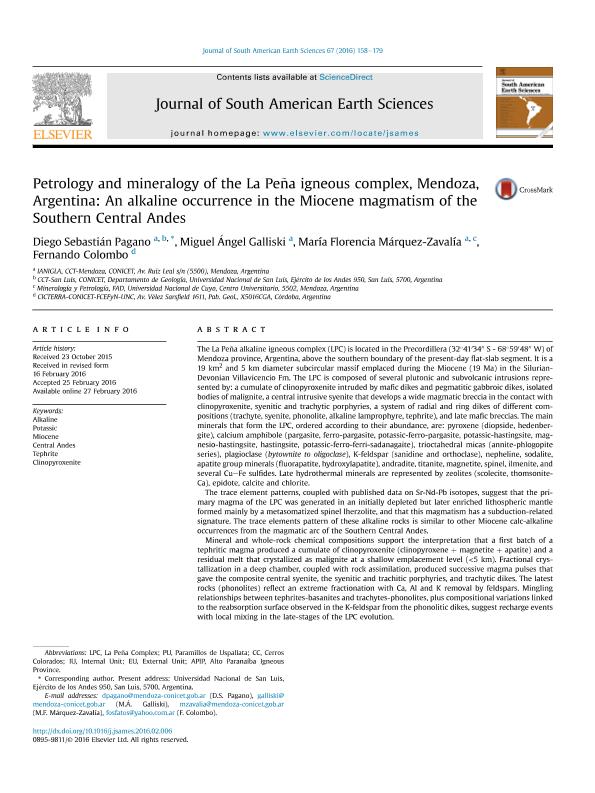Artículo
Petrology and mineralogy of the La Peña igneous complex, Mendoza, Argentina: An alkaline occurrence in the Miocene magmatism of the Southern Central Andes
Pagano Género, Diego Sebastián ; Galliski, Miguel Angel
; Galliski, Miguel Angel ; Marquez Zavalia, Maria Florencia
; Marquez Zavalia, Maria Florencia ; Colombo, Fernando
; Colombo, Fernando
 ; Galliski, Miguel Angel
; Galliski, Miguel Angel ; Marquez Zavalia, Maria Florencia
; Marquez Zavalia, Maria Florencia ; Colombo, Fernando
; Colombo, Fernando
Fecha de publicación:
04/2016
Editorial:
Pergamon-Elsevier Science Ltd
Revista:
Journal of South American Earth Sciences
ISSN:
0895-9811
Idioma:
Inglés
Tipo de recurso:
Artículo publicado
Clasificación temática:
Resumen
The La Peña alkaline igneous complex (LPC) is located in the Precordillera (32°41´34″ S - 68°59´48″ W) of Mendoza province, Argentina, above the southern boundary of the present-day flat-slab segment. It is a 19 km2 and 5 km diameter subcircular massif emplaced during the Miocene (19 Ma) in the Silurian-Devonian Villavicencio Fm. The LPC is composed of several plutonic and subvolcanic intrusions represented by: a cumulate of clinopyroxenite intruded by mafic dikes and pegmatitic gabbroic dikes, isolated bodies of malignite, a central intrusive syenite that develops a wide magmatic breccia in the contact with clinopyroxenite, syenitic and trachytic porphyries, a system of radial and ring dikes of different compositions (trachyte, syenite, phonolite, alkaline lamprophyre, tephrite), and late mafic breccias. The main minerals that form the LPC, ordered according to their abundance, are: pyroxene (diopside, hedenbergite), calcium amphibole (pargasite, ferro-pargasite, potassic-ferro-pargasite, potassic-hastingsite, magnesio-hastingsite, hastingsite, potassic-ferro-ferri-sadanagaite), trioctahedral micas (annite-phlogopite series), plagioclase (bytownite to oligoclase), K-feldspar (sanidine and orthoclase), nepheline, sodalite, apatite group minerals (fluorapatite, hydroxylapatite), andradite, titanite, magnetite, spinel, ilmenite, and several Cu-Fe sulfides. Late hydrothermal minerals are represented by zeolites (scolecite, thomsonite-Ca), epidote, calcite and chlorite.The trace element patterns, coupled with published data on Sr-Nd-Pb isotopes, suggest that the primary magma of the LPC was generated in an initially depleted but later enriched lithospheric mantle formed mainly by a metasomatized spinel lherzolite, and that this magmatism has a subduction-related signature. The trace elements pattern of these alkaline rocks is similar to other Miocene calc-alkaline occurrences from the magmatic arc of the Southern Central Andes.Mineral and whole-rock chemical compositions support the interpretation that a first batch of a tephritic magma produced a cumulate of clinopyroxenite (clinopyroxene + magnetite + apatite) and a residual melt that crystallized as malignite at a shallow emplacement level (<5 km). Fractional crystallization in a deep chamber, coupled with rock assimilation, produced successive magma pulses that gave the composite central syenite, the syenitic and trachitic porphyries, and trachytic dikes. The latest rocks (phonolites) reflect an extreme fractionation with Ca, Al and K removal by feldspars. Mingling relationships between tephrites-basanites and trachytes-phonolites, plus compositional variations linked to the reabsorption surface observed in the K-feldspar from the phonolitic dikes, suggest recharge events with local mixing in the late-stages of the LPC evolution.The emplacement of the LPC melts at a shallow crustal level was favored by the aperture of extensional NNW-SSE fractures genetically linked to a local brittle shear zone, active at 18-19 Ma during a strong compressional event, that initiated the regime of flat-slab subduction in this part of the Andes.
Palabras clave:
Alkaline
,
Central Andes
,
Clinopyroxenite
,
Miocene
,
Potassic
,
Tephrite
Archivos asociados
Licencia
Identificadores
Colecciones
Articulos(CCT - SAN LUIS)
Articulos de CTRO.CIENTIFICO TECNOL.CONICET - SAN LUIS
Articulos de CTRO.CIENTIFICO TECNOL.CONICET - SAN LUIS
Articulos(CICTERRA)
Articulos de CENTRO DE INVEST.EN CS.DE LA TIERRA
Articulos de CENTRO DE INVEST.EN CS.DE LA TIERRA
Citación
Pagano Género, Diego Sebastián; Galliski, Miguel Angel; Marquez Zavalia, Maria Florencia; Colombo, Fernando; Petrology and mineralogy of the La Peña igneous complex, Mendoza, Argentina: An alkaline occurrence in the Miocene magmatism of the Southern Central Andes; Pergamon-Elsevier Science Ltd; Journal of South American Earth Sciences; 67; 4-2016; 158-179
Compartir
Altmétricas



